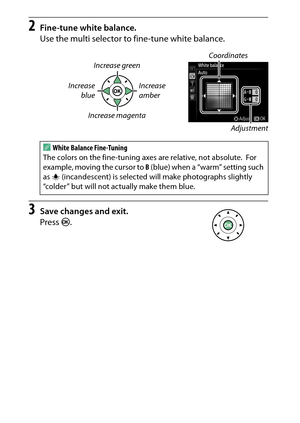Nikon Camera D3300 Reference Manual
Here you can view all the pages of manual Nikon Camera D3300 Reference Manual. The Nikon manuals for Digital Camera are available online for free. You can easily download all the documents as PDF.
Page 141
121 P, S, A, and M Modes A The Information Display Flash compensation options can also be accessed from the information display ( 09).AOptional Flash Units Flash compensation is also available with optional flash units that support the Nikon Creative Lighting System (CLS; see page 300). The flash compensation selected with th e optional flash unit is added to the flash compensation selected with the camera.
Page 142
122P, S, A, and M Modes Active D-LightingActive D-Lighting preserves details in highlights and shadows, creating photographs with natural contrast. Use for high contrast scenes, for example when photographing brightly lit outdoor scenery through a door or window or taking pictures of shaded subjects on a sunny day. Active D-Lighting is not recommended in mode M; in other modes, it is most effective when used with L(Matrix metering ; 0 114). 1 Display Active D-Lighting options. Press the G...
Page 143
123 P, S, A, and M Modes 2 Choose an option. Highlight On or Off and press J (0 345). DActive D-Lighting Noise (randomly-spaced bright pixels , fog, or lines) may appear in photographs taken with Active D-Lighting. Uneven shading may be visible with some subjects. Active D-Lighting can not be used at an ISO sensitivity of Hi 1. A“ Active D-Lighting ” Versus “D-Lighting ” Active D-Lighting adjusts exposure before shooting to optimize the dynamic range, while the D-Lighting option in the...
Page 144
124P, S, A, and M Modes White balance ensures that colors are unaffected by the color of the light source. Auto white balance is recommended for most light sources; other values can be selected if necessary according to the type of source: White Balance Option Description v Auto Automatic white balance adjustment. Recommended in most situations. J Incandescent Use under incandescent lighting. I Fluorescent Use with the light sources listed on page 126. H Direct sunlight Use with subjects lit by...
Page 145
125 P, S, A, and M Modes 1 Display white balance options. Press the P button, then highlight the current white balance setting in the information display and press J. 2 Choose a white balance option. Highlight an option and press J. P button
Page 146
126P, S, A, and M ModesA The Shooting Menu White balance can be selected using the White balance option in the shooting menu ( 0222), which also can be used to fine-tune white balance ( 0127) or measure a value for preset white balance ( 0 129). The IFluorescent option in the White balance menu can be used to select the light source from the bulb types shown at right.AColor Temperature The perceived color of a light source varies with the viewer and other conditions. Color temperature is...
Page 147
127 P, S, A, and M Modes Fine-Tuning White BalanceWhite balance can be “fine-tuned” to compensate for variations in the color of the light source or to introduce a deliberate color cast into an image. White balance is fine-tuned using the White balance option in the shooting menu. 1 Select a white balance option. Press G to display the menus, then highlight White balance in the shooting menu and press 2 . Highlight the desired white balance option and press 2 (if Fluorescent is...
Page 148
128P, S, A, and M Modes 2 Fine-tune white balance. Use the multi selector to fine-tune white balance. 3 Save changes and exit. Press J. Coordinates Increase green Increase blue Increase amber Increase magenta Adjustment AWhite Balance Fine-Tuning The colors on the fine-tuning axes are relative, not absolute. For example, moving the cursor to B (blue) when a “warm” setting such as J (incandescent) is selected will make photographs slightly “colder” but will not actually make them blue.
Page 149
129 P, S, A, and M Modes Preset ManualPreset manual is used to record and recall custom white balance settings for shooting under mixed lighting or to compensate for light sources with a strong color cast. Two methods are available for setting preset white balance: ❚❚ Measuring a Value for Preset White Balance1 Light a reference object. Place a neutral gray or white object under the lighting that will be used in the final photograph. 2 Display white balance options. To display the menus, press the...
Page 150
130P, S, A, and M Modes 3 Select Measure . Highlight Measure and press 2. 4 Select Ye s. The menu shown at right will be displayed; highlight Ye s and press J. The camera will enter preset measurement mode. When the camera is ready to measure white balance, a flashing D (L ) will appear in the viewfinder and information display.









